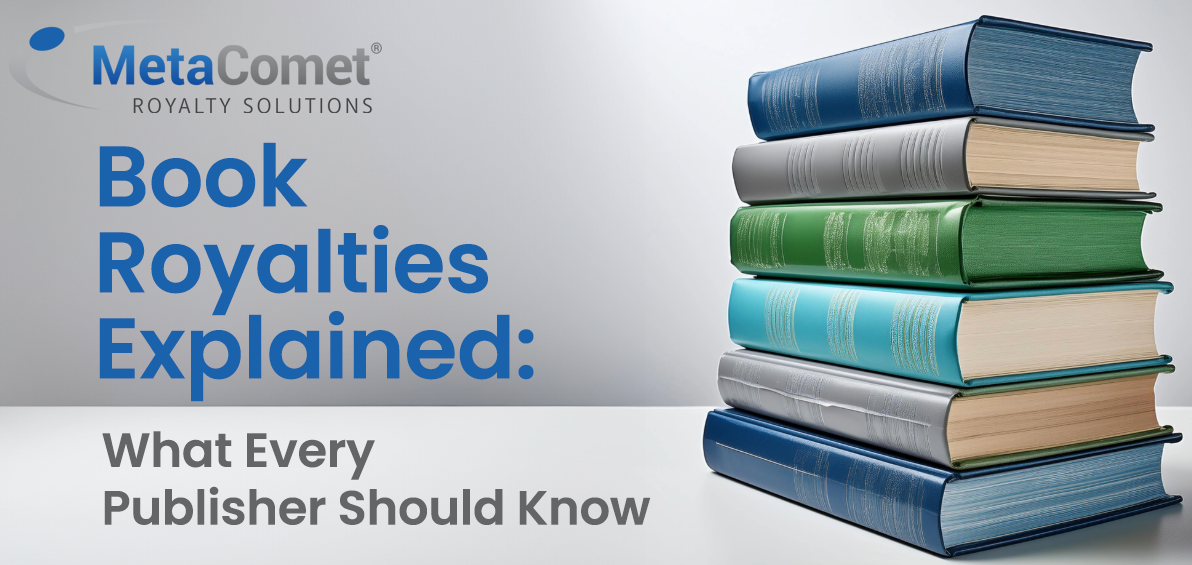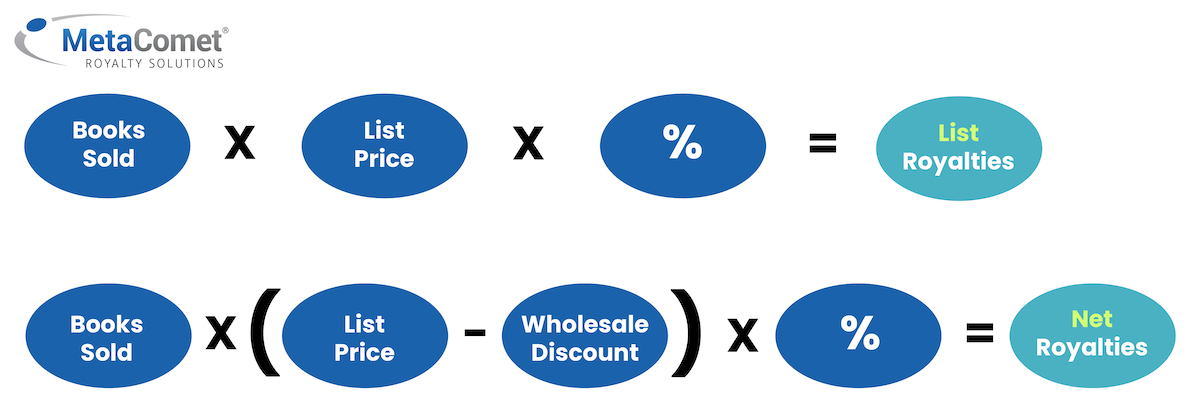Book Royalties Explained:
What Every Publisher Should Know
Book publishers tend to enter the business because of a love for books, not a love for royalty accounting. But royalties can be complex, and consume a disproportionate amount of the time spent on the business. This article is an introduction to book royalties and how they work, with information about how to simplify the process with the help of existing automation tools.

How Do Book Royalties Work?
Book royalties are payments authors receive from their publishers based on a percentage of book sales. The royalty terms are set when an author sells the rights to their work to the publisher.
The royalty model is a common alternative to a “work for hire” model, in which the author receives a one-time payment from the publisher. With royalties, both authors and publishers share the risks and rewards of the book’s success. Managing complex calculations becomes effortless when Royalty Tracker® automates book royalties from start to finish.
What Are Typical Book Royalties?
Book royalties fluctuate greatly depending on whether you’re working in a hybrid or traditional publishing model. In hybrid publishing, the costs of publication are shared, and authors may receive 50-90% of net sales.
In traditional publishing models, authors generally receive lower royalty rates, typically 25-50% of net sales for ebooks, 10% for paperbacks, and 15% for hardbacks. It’s also common for royalties to be adjusted for discounted sales, which are demanded by larger booksellers. When publishers license out rights for foreign editions or for film or television adaptations, authors typically receive 50% of those earnings.
Are There Different Types of Book Royalties?
Traditionally, there are two types of book royalties. “Retail royalties,” also known as “list royalties,” are calculated based on the retail price of the book. “Net royalties” are based on the publisher’s net revenue from book sales. Net royalties are more complicated to calculate and track, since there are likely to be varying levels of discounts the publisher offers to different retailers over the life of the publication.

How Long Do Book Royalties Last?
Contract terms may vary, but usually royalties are paid for the life of the work’s copyright. Current U.S. copyright law preserves the copyright for the duration of the author’s life plus an additional 70 years. So if a book continues to sell, the author’s heirs may receive royalties for up to 70 years after their death.
How Are Book Royalties Calculated?
The calculation of book royalty payments is informed by numerous factors, which can vary depending on how publishers structure their agreements with authors. The key factors in royalty calculation generally include:
- Sales: What was the number of books sold during the royalty period?
- Price: What is the book’s list price?
- Type of royalties: Retail or net?
- Royalty rate: What is the current royalty rate, and has an escalator been applied?
- Discounts: What discounts were given to retailers?
- Returns: How many returns were processed during the royalty period?
- Reserve: Is the publisher holding a reserve?
- Advance: Has the advance been fully recouped through royalty earnings?
(For more information on this topic, see our article How Are Royalties Calculated?)
Eliminate Complex Book Royalty Calculations!
MetaComet® Handles Every Variable.
Sales data, discounts, returns, reserves, advances – why calculate book royalties manually when our system processes every factor automatically? Eliminate calculation errors and save countless hours. Get your free consultation now.
What Should Be Included in a Royalty Agreement with an Author?
A book royalty agreement should address the following to protect both the publisher and the author and ensure clarity in the financial relationship:
- Rights & Formats: Clarify the rights being granted to the publisher, including the formats (print, e-book, audiobook, etc.), subsidiary rights (foreign language, motion picture, TV, merchandise, etc.), and territories covered. Will the author maintain ownership of the copyright?
- Royalty Rate: Clearly specify the percentage the author will receive from sales, and whether it will be based on the list price or net receipts. The royalty rate can vary based on format, distribution channels, and territory.
- Advance: If applicable, outline any advance payments the author will receive upfront, how they will be paid (in one lump sum or installments), and any events that will trigger the payments. For example, portions may be paid upon contract execution, manuscript delivery, and publish date.
- Bonus Payments: These might be triggered by mutually advantageous events such as bestseller list appearances or major awards.
- Escalation Clause: If applicable, detail how royalty rates may increase based on sales milestones (e.g., royalties increase after the first 10,000 copies sold).
- Royalty Reductions: These may be tied to deep discounts or small print runs.
- Frequency of Payments: Specify how often book royalties will be paid (quarterly, semi-annually, annually) and any provisions for minimum payout amounts to avoid small, frequent payments.
- Permissions and Releases: For any third-party materials included in the book (text, photos, or other), will the author or publisher be responsible for clearing and paying for the rights?
- Delivery Requirements: Deadlines and formats.
- Manuscript Acceptance: A clear definition of what the manuscript will consist of, approximate word count, and required editorial standards.
- Publication Details: Publication date and size of initial print run.
- Author Approvals: May include approval of the final work, artwork, promotion, and use of the author’s likeness.
- Advertising and Promotion: Include the number of complimentary copies the author may receive, and any discounts they are entitled to for purchase of additional copies.
- Reserve Against Returns: Include a clause allowing the holdback of a percentage of royalties to account for potential book returns and explain the timeframe for releasing any reserves.
- Audit Clause: Provide the author with the right to audit royalty calculations.
- Termination Clause: Outline the conditions under which the agreement can be terminated, including what happens to advances and rights after the contract ends.
- Warranties, Indemnities and Liabilities.
- Assignment of Rights and Obligations.
- Option on Next Work: Possibly a right of first refusal or an option to negotiate over the author’s next work.
- Mediation and Arbitration.
By addressing these elements in a royalty agreement, both parties will have a clear understanding of their obligations and how royalties will be managed throughout the book’s lifecycle.

How Can Book Royalty Management Be Simplified?
The process of calculating book royalties can quickly become complex, error-prone, and time-consuming. A system of spreadsheets may help, but as a publishing company grows and its accounting demands become more sophisticated, a homegrown system becomes less effective. Publishers often find themselves bogged down by the sheer amount of time needed for royalty calculations, resulting in delays, inaccuracies, or missed payments to authors.
MetaComet® recognized this challenge over 20 years ago, and designed Royalty Tracker® and our other automation tools to simplify royalty management. These tools can cut the time required for royalty management by up to 95%, while eliminating errors and reducing frustration and stress. The software guides the user through setting up rules for processing their company’s royalty files. Once the initial set-up is complete, the user can upload sales files then complete their royalty calculations and send out statements and payment files with the click of a button. The royalty records are maintained on a secure server, making audits and reviews easy.
Learn More
Would you like to see if the MetaComet® book royalty management solution is the right one for your business? Please contact us for a free consultation, and we’ll be happy to answer all of your questions.
If you’re in a different industry other than book publishing, you may be interested in our article Different Types of Royalties & How They Work.

David Marlin is the President and Co-Founder of MetaComet® Systems, a prominent provider of royalty automation tools. Since founding the company in 2000, David has spearheaded the development of a suite of best-in-class systems that effectively facilitate royalty processes for nearly 200 publishers. David has also served as the chair for The Book Industry Study Group’s Rights Committee and Digital Sales Committee.
Before establishing MetaComet Systems, David served as a technology consultant for renowned publishers, collaborating with notable companies such as Random House, Penguin, HarperCollins, Holtzbrinck, Macmillan, Scholastic, Time Warner, and many others. David holds both an MBA and a BA from Columbia University in New York.
Contact Us
"*" indicates required fields

